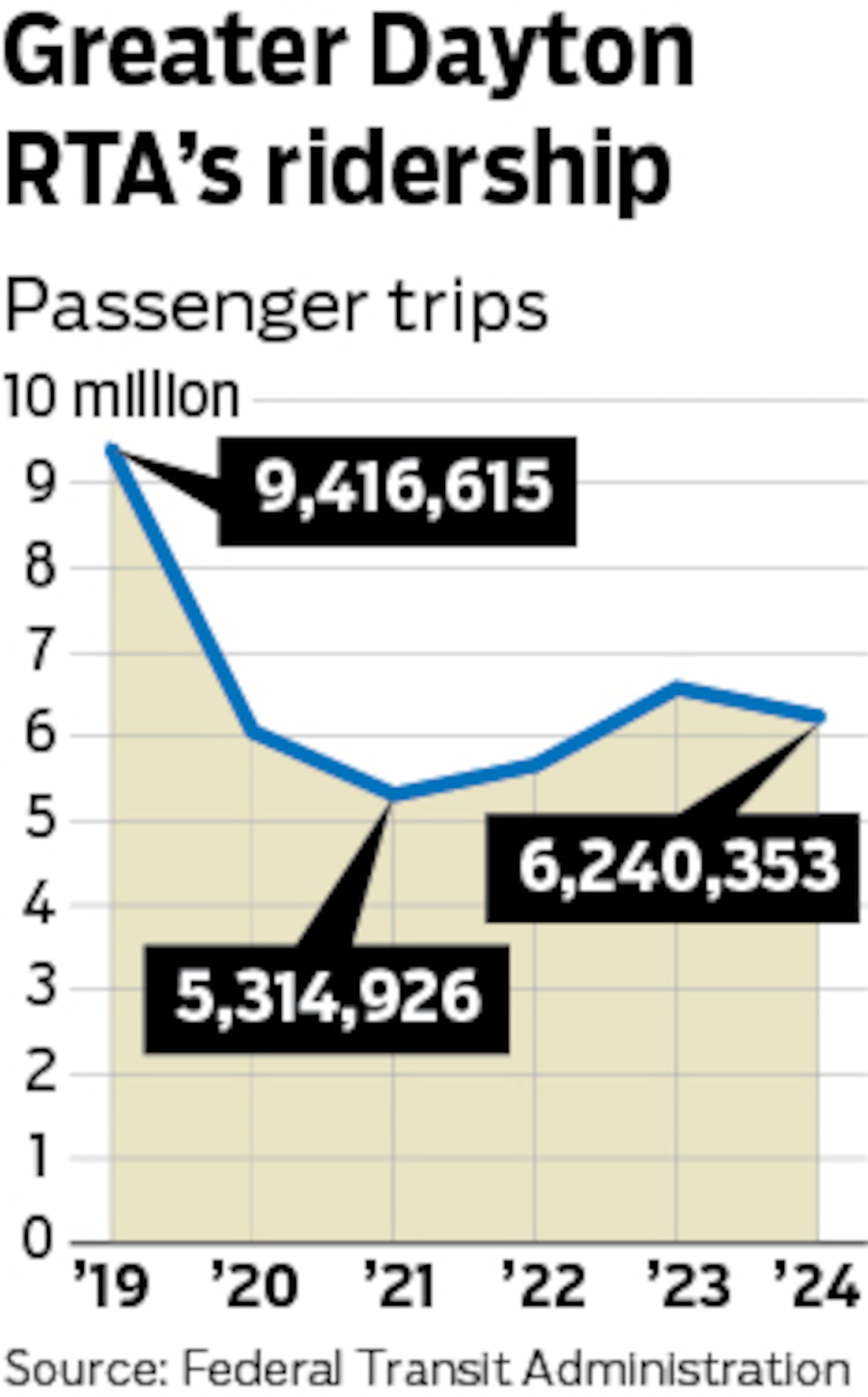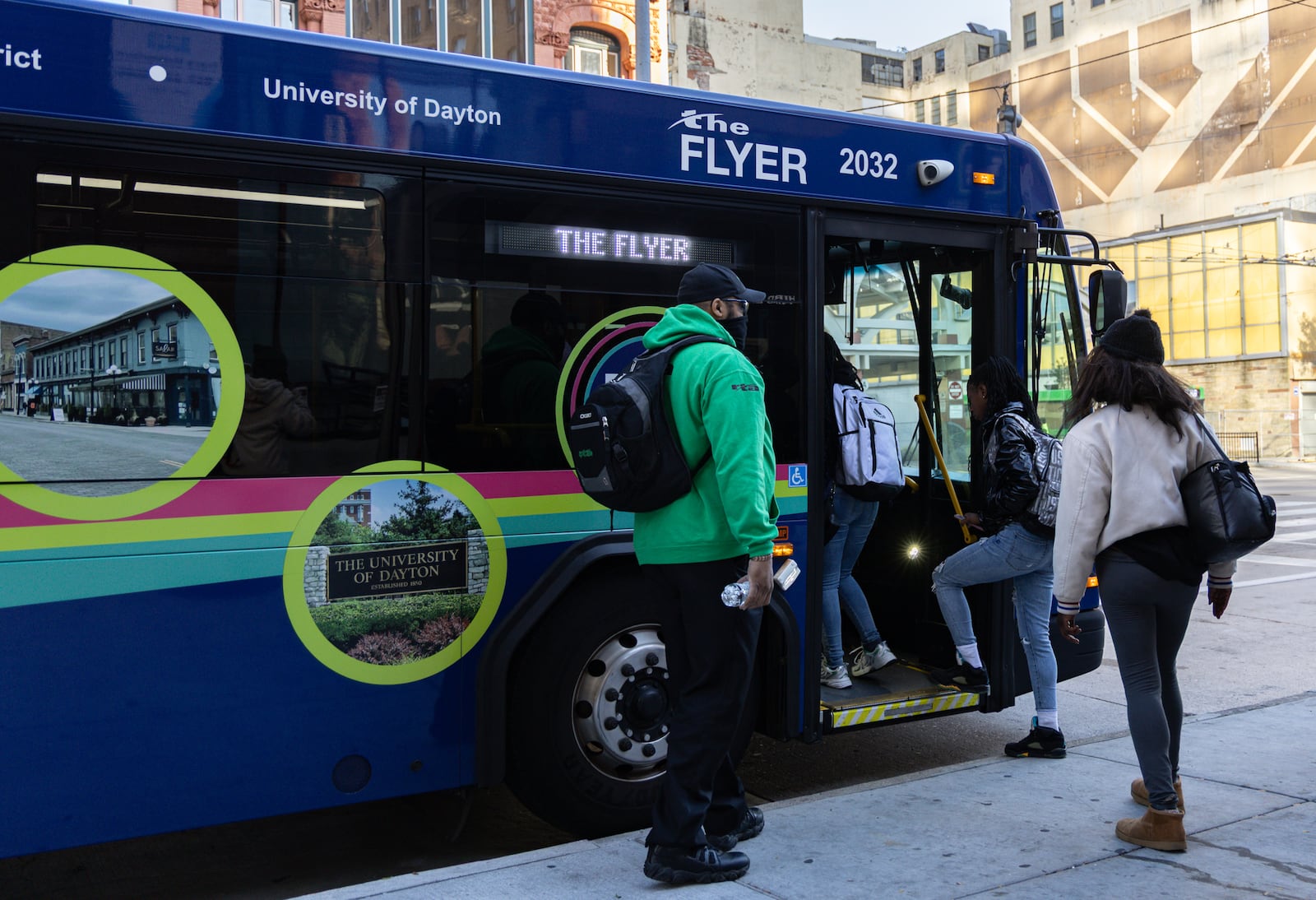Greater Dayton RTA must adapt to changing commuting patterns and community needs, and the agency moving forward may devote more of its resources toward the growing Connect On-Demand service, which provides door-to-door transportation primarily to the elderly and people with disabilities and medical challenges, said Greater Dayton RTA CEO Robert Ruzinsky.
“If the fixed ridership continues to decline and the need for door-to-door continues to grow, I am going to have to put resources where the need is,” he said.
Credit: Bryant Billing
Credit: Bryant Billing
Greater Dayton RTA served about 6.2 million riders last year, which was a decrease of about 5% from 2023, says data from the Federal Transit Administration. Ridership increased about 16% in 2023 and 7% in 2022.
But the gains in 2022 and 2023 were part of a rebound after passenger levels plummeted during the first years of COVID. RTA ridership sank 36% in 2020.
The transit agency had about 9.4 million passenger trips in 2019 — nearly 3.2 million more than in 2024.
Work-related
Nick Pate, 20, rides the bus with his wife, Sade Pate, to get part way home from their jobs at an Amazon facility near the Dayton International Airport.
Nick and Sade typically ride to work with their friends and coworkers and then take an RTA bus to get downtown, where they order a Lyft, a ride-sharing service, which picks them up and drops them off at their doorstep.
Credit: Bryant Billing
Credit: Bryant Billing
If they didn’t use Lyft, the Pates would have to take multiple buses to get home, and they said that would be a headache.
Nick said RTA is an important service that is inexpensive and reliable, but he hopes to save up to buy a car. Sade said, “The bus is a good way to get to work so that you can get the money to get a car.”
RTA has estimated that between 60% to 70% of passenger trips are work-related. But Ruzinsky said a significant number of people who used to work downtown before COVID no longer do, and that has led to less demand for public transportation.
Dayton’s downtown, like downtowns nationwide, has seen a decrease in the number of employees post-COVID, said Jes Sands, public relations and marketing manager with the Downtown Dayton Partnership.
Many employers switched to remote or hybrid work arrangements during the public health crisis and downsized their offices. About 1 million people in Ohio worked remotely either some or all of the time in 2023, says the U.S. Bureau of Labor Statistics, which equates to nearly one in five workers in the state. The number of U.S. employees who worked primarily from home tripled during COVID.
Credit: Bryant Billing
Credit: Bryant Billing
Before the pandemic, more than 1,000 people worked at Premier Health’s building at 110 N. Main St. in downtown. But by early 2023, the office tower only housed about 200 employees, and Premier decided to sell the building.
“Like many large employers, Premier Health has adapted to flexible work models since the pandemic,” Premier Health said in a statement. “Administrative caregivers continue to work in a mix of on-site and remote arrangements to best support those operations.”
CareSource, another major employer in Dayton, has flexible work options, including hybrid and remote positions, which the organization says has been crucial to attract and retain a highly qualified workforce.
“As a company, we value and encourage in-person connections,” CareSource said in a statement. “To enhance collaboration, we require applicable employees to be in the office Tuesday through Thursday. Additionally, thousands of CareSource employees travel to our downtown headquarters each year, experiencing Dayton firsthand and contributing to the local economy through hotel stays, transportation and dining.”
Downtown’s population has been growing, and a bunch of new housing units have been built in the center city, attracting many young renters.
But Ruzinsky said people who live downtown are less likely to ride the bus than people who work downtown and live somewhere else.
Also, while young people are less car centric than previous generations, they often prefer to get around on bikes or scooters and use ride-sharing services, like Uber and Lyft, instead of taking the bus, Ruzinsky said.
The impact
RTA launched new service and routes in the last couple of years that officials hoped would grow ridership, including the West Connector, the North Connector and a Kettering Loop (Route 28). But Ruzinsky said so far those routes have not taken off, though it is still early, and passenger levels could improve over time.
The RTA this past summer launched a new express route that takes people from downtown to the National Museum of the U.S. Air Force, which is one of the largest tourist destinations and entertainment attractions in the region. The service is supposed to benefit new hotels that have opened downtown.
RTA recently also began operating Route 3, which travels between the Eastown Shopping Center in southeast Dayton and the Old North Dayton area. Stops along the way give riders access to Ballpark Village, Dayton Children’s hospital, the Oregon District, Kroger on Wayne Avenue, Belmont High School and other destinations.
Flat or declining ridership numbers are not a huge financial threat to the RTA, since passenger fares in recent years have accounted for less than 10% of the agency’s revenues. Most of RTA’s funding comes from sales taxes and federal sources.
RTA received about $6.4 million in fares last year, while operating expenses were around $74.6 million, according to the Federal Transit Administration. RTA’s actual budget for 2025 is projected to be about $79 million, a roughly 3% increase from the 2024 actual budget.
Connect On-Demand
RTA operates fixed-route buses and Connect On-Demand buses, which provide door-to-door service to elderly residents and community members with disabilities, medical conditions and other challenges.
Although fixed-route ridership declined last year, Connect On-Demand service had 229,500 passenger trips — a 20% increase from the prior year. On-Demand ridership has increased for three consecutive years and has surpassed 2019 passenger levels.
Ruzinsky says he expects that RTA will see an increase in On-Demand service over the next decade, while fixed-route service likely will dip or stay flat.
About the Author




